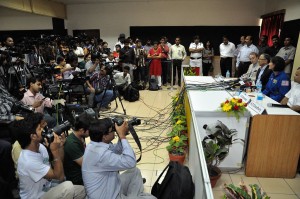6.5 Journalistic Sources
Another major category of information sources is journalistic materials produced for a general audience and distributed through the popular media (newspapers, magazines, radio, television, Web sites, etc.). Journalistic sources also include industry-specific news sources such as PRWeek, Advertising Age, or Editor & Publisher magazine—we will commonly refer to these specialized business oriented sources as trade publications.
Much of the work that media professionals do relies on the previous journalistic work in that area. The basic rule to “check the clips” before starting on any information task applies to newsrooms of all types. Advertising libraries maintain “tear sheet” files of ad examples from magazines and newspapers in a myriad of product and service categories so ad professionals have some idea about how a particular item has been advertised before launching off on a new campaign. Public relations professionals are judged, in part, by the coverage their clients receive in the popular media and therefore use a variety of means to document where their news releases were published in media outlets.

News media moved to digital production of their newsprint products more than thirty-five years ago. News organizations, with rare exception, now have a digital version of their print, television or radio counterpart available on the Web. And in the last decade, many digital-only news publications have been created. What this means for the communicator is unprecedented access to the news coverage from journalistic organizations around the world.
Many news sites will give access not only to current stories, but to the archive of previously published stories. Sometimes free, sometimes for a fee, these archives will be important resources to communicators needing background on a topic or event. Often, news sites will make the databases of statistics they have used to report a story available. The “computability” of the digital space allows the user of a news database to find the crime statistics, or school test scores, for example, for the specific area they are interested in.
Many journalistic organizations are making interactive, digital versions of their publications available in addition to their print versions, so you can see all the articles and ads as they appeared in the print publication. This is of particular interest to strategic communicators who need to track the placement and play of stories and ads.
As potential contributors to your information search, journalistic sources might be helpful in generating ideas for your news message (how have others written about this and what could we choose as a new “angle”), identifying possible problems or crises you might need to address with your PR messages (a news report identifies falling public confidence in your client organization), or suggesting an opportunity for a new ad approach (a news report might document that more women are doing home repairs so your client home improvement store should target women).
Depending on the context of the information request you present them, you will get different kinds of information from journalists as interviewees. If the media organization itself is the focus of the research, the information you will get is likely to be the “party line” of the organization. If you are tapping one of the employees of a media organization about a story they have written, you are likely to get more of a personal view of what went on in the crafting of that message. If you are seen as any kind of competitor, you are unlikely to get any information at all. The products of journalistic organizations are messages and if the journalist believes you are going after the same sort of message, that reporter won’t be a very willing contributor.

